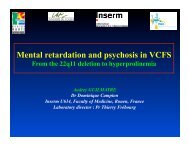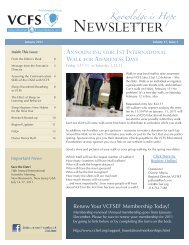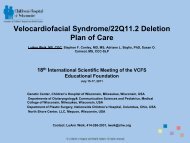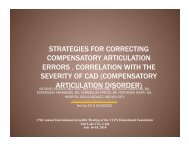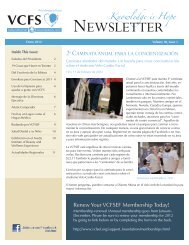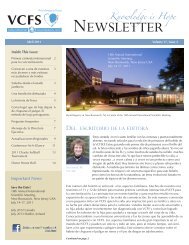English Newsletter - Velo-Cardio-Facial Syndrome Educational ...
English Newsletter - Velo-Cardio-Facial Syndrome Educational ...
English Newsletter - Velo-Cardio-Facial Syndrome Educational ...
You also want an ePaper? Increase the reach of your titles
YUMPU automatically turns print PDFs into web optimized ePapers that Google loves.
Page 8VCfsef January 2012 newsletterBuyer Beware!(Continued from page 7)2. Encourage debate on the evidence3. Believe data not “experts”4. Spin more than one hypothesis5. Don’t overly attach to a hypothesis6. Quantify the findings7. Every link in the argument chain must work8. Count the hits and the misses9. A case study is not experimental10. If it is too good to be true, it probably is NOT true.11. Determine if the information obtained followed thescientific methodology12. Be wary of information from the popular pressIf you did not have an opportunity to hear Dr. Lof’s presentationat the VCFSEF Annual meeting in July, I encourage you to go tothe “Members” section on our website (www.vcfsef.org) toobtain the handouts from his talk as well as handouts andPowerPoint presentations from the other notable speakers. Ifyou are not currently a member of the VCFSEF, this is one greatbenefit of joining. A Membership application is included in thisnewsletter or can be found on our website.As a seasoned speech-language pathologist, I found Dr. Lof’spresentation empowering. Over the years I have witnessed thecomings and goings of a variety of intervention programs –some based on solid, peer reviewed research, others based onless rigorous studies, and some based on anecdotal reports. Forexample, some of the current trends in speech and languagetherapy that could fall in the category of quackery include oralmotor therapy and blowing horns and whistles to remediatespeech production deficits and/or improve velopharyngealfunction, Auditory Integration Therapy to ameliorate attendingand listening comprehension difficulties, and dietary supplementsto improve speech motor planning difficulties. Again, asprofessional and lay consumers of therapy programs, it isimportant to exercise the above mentioned “skeptical thinking”strategies. There is an abundance of scientific evidence showingthe lack of efficacy of these procedures, yet some unsuspectingconsumers get sucked into these procedures by persuasiveproviders.At the beginning of this article I lamented for an “app” thatwould help choose appropriate therapy options, but it isimportant to realize that even a published “app” may not havebeen subjected to critical standards of validity and efficacy. Inthis world of instant information access, the buyer must beware!It behooves us all to do further research into the program and itsauthors. With healthy skepticism, we can become betterinformed and educated consumers for whatever is being offered.there’s no PlACe like AmediCAl homeBy: Jack Levine, MD“Every child deserves a medical home” is the motto ofthe American Academy of Pediatrics (AAP). Nothingcould be truer for children with <strong>Velo</strong>-<strong>Cardio</strong>-<strong>Facial</strong><strong>Syndrome</strong> (VCFS). Care from specialists is critical, butcommunity based family centered, preventative andcoordinated pediatric care is the key to the health of allchildren and especially those with special health careneeds. Now, don’t go looking for that perfect “MedicalHome” – there is no such thing! According to the AAP,“a medical home is not a building, house, or hospital,but rather an approach to providing health care servicesin a high-quality and cost-effective manner. Childrenand their families who have a medical home receivethe care that they need from a pediatrician or physicianwhom they trust. Pediatricians and parents act as partnersin a medical home to identify and access all the medicaland non-medical services needed to help childrenand their families achieve their maximum potential. . .where care is accessible, family-centered, continuous,comprehensive, coordinated, compassionate andculturally competent.”Above all else, the medical home is community–based.Children with VCFS should get care near where theylive just like their brothers and sisters and neighbors.Care is family-centered, based on trust and mutualresponsibility. The family is recognized as the center ofstrength and support for the child and it plays a centralrole in care coordination and decision making. Specialistsmay be at various locations and distances, butthe place where the doctor and family come togetherfor discussion and decisions should be close to home.The health care provider (HCP) knows the family andcan help make important decisions. This is especiallyimportant when there are multiple medical options andduring transitional times (such as Early Intervention tothe Committee on Preschool Education (CPSE)).The child is treated as “a person” and all their needs,medical, educational, developmental and psychosocial,are addressed. In other words, they are treated likechildren first and not just children with VCFS. Especiallyimportant to families of children with VCFS is coordinatedcare. The medical home can help to develop a planand to coordinate care among the many providers inthe lives of children with VCFS. By having knowledgeof relevant community services and systems of support,the medical home helps with referrals, finding consultants,support groups and family resources.Continued on page 9



